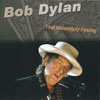BOB DYLAN : THAT MELANCHOLY FEELING
Disc One
- Things Have Changed
- She Belongs To Me
- Beyond Here Lies Nothin'
- The Night We Called It A Day
- Pay In Blood
- Melancholy Mood
- Duquesne Whistle
- That Old Feeling
- Tangled Up In Blue
Disc Two
- High Water (For Charley Patton)
- Why Try To Change Me Now?
- Early Roman Kings
- I Could Have Told You
- Spirit On The Water
- Scarlet Town
- All Or Nothing At All
- Long And Wasted Years
- Autumn Leaves
- Blowin' In The Wind
- Love Sick
bonus Tracks : - How Deep Is The Ocean
- What'll I Do?
- I'm A Fool To Want You
Label : Tweedle Disc
Venue : Wolf Trap-Filene Center, Vienna, Virginia, USA
Date : July 6, 2016
Quality : Audience Recording
Concert Review (Roger Catlin - Boblinks) : I went to the second of two stops by Bob Dylan and his band at Wolf Trap in Virginia Wednesday, thinking maybe that he'd change up the set a bit from opening night. That was the case for decades, of course, when he'd switch roughly a third of the show with more unusual offerings on subsequent nights at a venue. But as he informed me in the very first song of a set that hadn't altered a whit from the night before, or the night before that, "Things Have Changed." That Dylan at 75 is playing pretty much the exact same set at every stop in the last couple of years is just as noteworthy as him mixing it up for all those years. Are we to believe he's arrived at last at the perfect arrangement of songs in his shows? At least it is one that has at last fully caught up to his recorded output, with a good portion of the titles drawn from his dreamy, unexpectedly compelling reading of old love songs on the albums "Shadows in the Night" and "Fallen Angels," in which he clears up his voice enough to croon the old melodies, fraught with heartbreak and regret. Indeed, a couple of songs were ones that weren't even on "Shadows in the Night" or "Fallen Angels" - "I Could Have Told You" and "That Old Feeling" (which replaced a third unreleased song on the tour, "How Deep is the Ocean?") - indicating that his hankering for the past may result in a third album in the trilogy (unless you count the album of Christmas standards as his first such foray). Those who worry about this wholesale move to songs Sinatra once did are discounting how well they're adapted by his longtime electric string band that relies largely on the crying melodicism of Donnie Herron's pedal steel guitar, which also provides a bridge to the other songs of the set - the big chunk of rockers from his last album of his own songs, "Tempest," and the now-handful of older songs that are sprinkled in. Actually, they all fit in pretty well - the wistfulness of short elegies "The Night We Called It A Day," "Melancholy Mood," Why Try to Change Me Now," "All or Nothing at All" serve as good balance to the more biting, cynical grit of his own "Tempest" output, with songs like "Pay in Blood," "Long and Wasted Years," and "Scarlet Town." The "Tempest" songs, unfairly dismissed when that album was released, have really proven themselves on tour, where "Early Roman Kings," with its "Hoochie Coochie Man" riffs, is easily on par with "Highway 61" as a blues stomper. Those are all played along the lines of the recordings which is more than you can say about, say, "Tangled Up in Blue," whose musical architecture is so different it might as well just be a reading of the (somewhat changed) lyrics. Still it had a bit of his harmonica playing, as did an early "She Belongs to Me." Other than when he occasionally sat at the piano for some songs; he stood before a microphone center stage. Still perplexing to me after a decade is how he completely abandoned the guitar after basing a career on it. His reading of "Blowin' in the Wind" in the encore, with the band, and him on piano, was somewhat reverent though it hardly conveyed the compounded weight of its lyrics, which, over time, have not had any of its essential questions answered. The gulf between recent Dylan and old American standards isn't large; indeed, he's as much a part of Americana as anyone. But some of his own tunes, such as the sprightly "Duquesne Whistle" or carefree "Spirit on the Water" might be stringband workouts from one of the 1930's bands he so admires and collects. Herron's banjo on "High Water (For Charley Patton)" brought it closer to the era of the bluesman in the title. Dylan evokes the past as well in his stance on stage - a wide one, his hip cocked, hand in pocket, in cowboy boots and gaucho attire, all black but for the white belt, white stripe in his pants, the silver of a watch fob on his chest and of course the white, wide brimmed flat hat on his head. With some of the lowest lighting of any show on tour, using only footlights and backlighting by big low-watt Hollywood-style klieg lights to go with the Oscar, it's sometimes hard to discern the black clad figures on stage at all sometimes. But that white brim catches the footlights and seems to be floating on its own on stage as the music plays. When songs end, particularly the standards, Dylan directs the songs' ends or shoots finger points on each side as if he's a reincarnated Lash LaRue.
